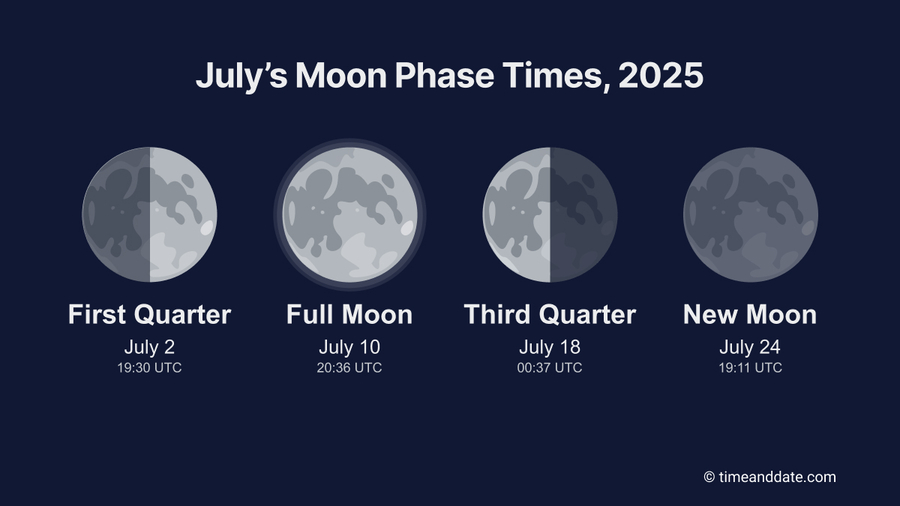
When to See the Full Moon in July
July’s Full Moon is at its most illuminated at 20:36 UTC on July 10, 2025.
The Moon always appears full in the days before and after peak illumination. Full Moon is the only phase where the Moon is up all night, with moonrise and moonset occurring around sunset and sunrise.
See where the Moon is right nowMoon Phase Times July 2025
| Moon Phase | Date | Time |
|---|---|---|
| First Quarter | July 2 | 19:30 UTC |
| Full Moon | July 10 | 20:36 UTC |
| Third Quarter | July 18 | 00:37 UTC |
| New Moon | July 24 | 19:11 UTC |
Moon phases are divided into primary and intermediate: Primary Moon phases happen at a specific moment in time, while the intermediate Moon phases occupy the times in between.

The Moon & Planets in July
Around July 16, the Moon meets up with Saturn. In the Northern Hemisphere, look up just before sunrise to see the close approach between a Waning Gibbous Moon and the Ringed Planet. Examples from our Night Sky Map in New York, USA, London, UK, or in Sydney, Australia.
On July 20, the Moon occults the Pleiades star cluster in New York and the rest of the USA and Canada. Because the Moon is in the waning crescent phase, it will be less bright and look quite spectacular as it passes in front of the stars also known as the Seven Sisters. The links go to Alcyone, the brightest star in the cluster. Click on the stars around to explore the names of the Pleiades.
In other locations, look for the cluster near the Moon on July 20–21, including London and Sydney.
Around July 21, the Moon meets up with Venus. Get up early to find a thin, Waning Crescent Moon with a very bright Venus on the eastern horizon. See the sky map for New York, London, and Sydney.
Around July 23, the Moon catches up with Jupiter. A thin, thin crescent of an almost New Moon creeps past Jupiter—and you can find Venus a bit higher in the sky, too. But you must be quick: the pair are only visible for an hour or so before sunrise in New York, London, and Sydney.
Around July 28, the The Moon cozies up to Mars. The Waxing Crescent Moon has a close approach with the Red Planet. Find the two above the western horizon just after sunset in New York and Sydney. Unfortunately, at the latitude of London, the sky is too bright to see Mars.
The Full Moon in July Is the Buck Moon
July’s Full Moon is known as the Buck Moon, named after the new antlers that emerge on a deer buck’s forehead around this time. Other Native American names are Salmon Moon, Raspberry Moon, and Thunder Moon.
The Celtic and Old English names are Claiming Moon, Wyrt Moon, Herb Moon, and Mead Moon. The Anglo-Saxons called it Hay Moon after the hay harvest in July.


